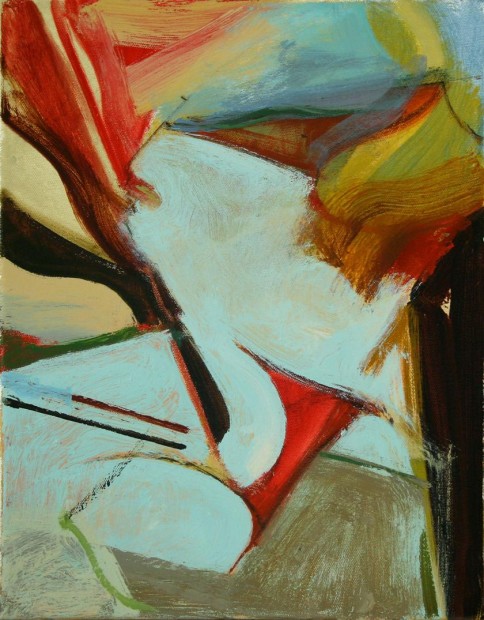There is a proliferation of exhibitions featuring abstract painting in Houston right now. Gallery Sonja Roesch, Sicardi Gallery, and Hiram Butler Gallery have group exhibitions featuring abstract painters, and there are several galleries featuring solo exhibitions by painters– Zachariah Rieke at Wade Wilson Art, Michael Kennaugh at Moody Gallery, Geoff Hippenstiel at Devin Borden Gallery, and Jerry Cabrera at G Gallery. The Contemporary Arts Museum Houston’s most recent Perspectives exhibition features McArthur Binion‘s waxy abstractions, and across the street, the Museum of Fine Arts Houston is hosting a retrospective of Jules Olitski‘s paintings.
The fact that there is an exhibition of abstract painting in nearly every cluster of galleries in Houston makes you wonder what might be behind this surge– economics, aesthetics, politics, gender, or the constant cycle of painting dying and being reborn . . . It’s hard to say. Nonetheless, it is somehow reassuring to see artists still working on the basic tools of their craft, such as color, form, and texture, in ever more inventive ways. And there is something profoundly mysterious and beautiful about an artistic language that is at once intensely idiosyncratic and nearly universally understood. One thing that is certain is that you can learn a lot about artmaking by looking at these exhibitions and seeing how each artist makes their own way through the myriad of influences from the history of painting to create images that push that artistic language forward in their own way.




6 comments
In my cursory study of Houston’s art history, I’d say that Houston has always been a painting town and in particular an abstract painting town. While in the 80s and 90s, strains of sculpture, conceptual art, installation and performance came to the fore, it seems like the abstractionists were toiling away in the background. To me, this recent flowering of abstraction–which I’ve also noticed–is simply the new flowering of a hardy perennial.
I hadn’t thought of that. There is a long history of abstraction in Houston. I love to look at that old 1985 catalog from the Museum of Fine Arts Houston– Fresh Paint: The Houston School, http://books.google.com/books/about/Fresh_paint.html?id=GpLqAAAAMAAJ Although, the artists featured in that exhibition were not all abstract painters . . .
Also, why the reflowering NOW? Is this younger generation connected to the earlier “Fresh Paint School”?
The excitement in Houston abstract art comes from our past and all the great Houston painters who over the years have influenced the younger generations to come.
We have a rich history of painting and abstract painting with all the fine shows and galleries that have blessed this city over the years such as: Janie C Lee, CAMH,MFAH, Texas Gallery, Moody Gallery etc. My first time to visit MAFH was a huge show of Paul Jenkins which, I think was in the late ’60’s and then there was a gallery down the street from CAMH showing Olitski etc. That vibe is still alive and well in Houston!
With Fresh Paint, Barbara Rose was specifically looking for non-abstract painting. She wrote, “Among the most obviously remarkable features of Houston art is the shift of focus away from purely formal concerns toward a humanistic figurative art emphasizing content, moral concerns, and at times literary narrative.” The problem with this statement is that it would be hard to do a painting show in Houston in 1985 without including abstractionists like Joseph Glasco, Dorothy Hood, Dick Wray, etc.
I think the continuity is not always passed down artist to artist, but lives in the tastes of curators, gallerists and collectors. So one can imagine a young abstract painter who moves to Houston who knows nothing of Dorothy Hood or Dick Wray, but whose work ends up being championed by people who did know those earlier Houston abstractionists. In this way, the older generations of abstract painters indirectly influence younger generations.
Definitely true, especially for Alison de Lima Greene and Betty Moody from my list in the first paragraph. Alison wrote a fascinating history of modernism in Houston a few years back: http://www.artlies.org/article.php?id=149&issue=41&s=1
I think taste might also play a role in terms of how trends are received here. It seems to me that other large art markets, Los Angeles and NYC for example, move fast in terms of trends and innovations that come and go. Houston seems much less enamored with such things. Art that gets a foothold here– abstract paintings, socially engaged photography, and parodic performance for example– sticks around for a long time with constant support.
Gave up representation work in the 1960’s when the universities were still teaching adult sand-pile, but took a totally non-AE approach and have been doing this since with flurries of installation and performance episodes. David Brauer put together an exhibition at Glassell, “Artist’s Progress,” November 1993 with Jack Boynton, Don Foster, Dorothy Hood, Charles Schorre, Don Shaw, Dick Wray and myself. It surveyed work 1943-’63 and then the late 1960’s thru 1993.
The dominate work was abstraction while demonstrating that most had their early flings with representation. Houston galleries have “always” had abstract work; and, since 1849 the direction has been to delimit that that does does not speak of is time. We are in a dominate
architectonic slope that certainly is abstract even though Gerhard Richter baits us with images that are often considered representational. But all on-object art represents …………….!!!